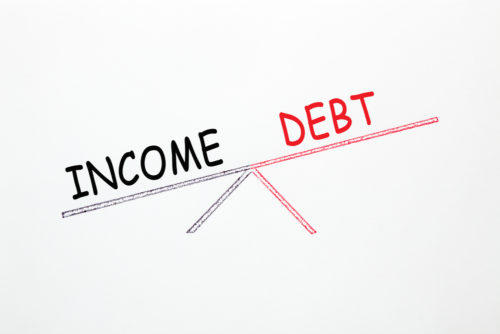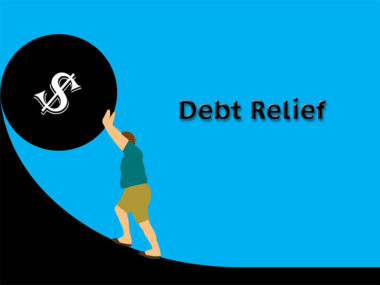When you take out a loan, lenders will often bring up your debt-to-income ratio. This calculation gauges your ability to pay off debts with your income on a monthly basis.
Your debt-to-income ratio (DTI) helps lenders decide whether you’re able to pay back a loan. It’s important to be aware of where your DTI stands before you request a loan.
Table of Contents
What Is Debt-To-Income Ratio?
Your debt-to-income ratio is a straightforward calculation of your monthly debt payments divided by your gross monthly income.
There are two ways that your DTI can be calculated:
- Front-end debt-to-income ratio: This purely takes into consideration your housing costs compared to your gross income. This could include your mortgage payments, homeowner’s insurance, homeowner’s association fees, and property taxes.
- Back-end debt-to-income ratio: This is your entire DTI. It includes your housing-related payments as well as car loans, credit card bills, child support, student loans, and any other qualifying monthly debt payments.
Your DTI is typically expressed as a percentage. For instance, a DTI of 25% would mean one quarter of your income goes towards paying back your debts each month.
How to Calculate Your Debt-To-Income Ratio
Figuring out your debt-to-income ratio is fairly simple. You can calculate your DTI in two steps.
Begin by adding up all of your debts, including:
- Your mortgage payment — this will often have your property taxes and homeowner’s insurance included.
- Rent.
- Any other housing-related debt payments.
- Minimum credit card payments.
- Alimony or child support payments.
- Student, auto, home equity, or any other personal loan payments.
As a general rule of thumb, if a debt shows up on your credit report, you should include it in your DTI calculation.
Next, divide this number by your total gross income. Gross income is your monthly pay before taxes or other deductions have been taken out.
The percentage you get from this calculation is your DTI.
As an example, say Sarah Smith wants to calculate her DTI. She begins by adding up the following:
- A $1,200 mortgage payment that includes her property taxes and homeowner’s insurance.
- A $350 car payment.
- A $250 student loan payment.
- A $150 minimum credit card payment.
This adds up to $1,950 in total debt payments each month.
Next, she divides her total debt by her gross monthly income, which is $6,500 and discovers that her DTI is an even 30%.
Why Your Debt-To-Income Ratio Matters
While your debt-to-income ratio may be easy to calculate, that doesn’t change the fact that it’s a crucial number. Your DTI enables a lender to decide whether you would be able to add more debt to your expenses and still be reasonably expected to pay it back on time.
Say for instance you’re applying for a mortgage and the monthly payments would make your DTI exceed 50%. A lender may not be able to approve your application simply because your DTI is too high and you cannot be reasonably expected to make your payments.
Does Your Debt-To-Income Ratio Affect Your Credit Score?
Your debt-to-income ratio is not tied to your credit score. DTI takes into account both your debt and income, whereas your credit score does not take your income into consideration.
Nevertheless, you still want to be careful, as your DTI can have an effect on your credit score in more subtle ways. For instance, if your DTI is high, that means a large portion of your income is going towards your debts. If this is the case, you may be leaning on your credit more heavily.
This would increase your credit utilization ratio, which can seriously affect your credit score. Your credit utilization ratio is the percentage of available credit that you’re using. A good credit utilization ratio is 30% or less.
If you have $5,000 in available credit and you end up using $3,000 to help cover expenses because you don’t have enough income each month, your credit utilization ratio would be 60% and would almost certainly decrease your credit score.
What Is an Ideal Debt-To-Income Ratio?
As a general rule, the lower your debt-to-income ratio the better.
Say you have an initial DTI score of 25%. If, over the course of a year of payments (and maybe a promotion or bonus thrown in, too) that number drops to 20%. That would mean an additional 5% of your gross income is not tied up with paying back debts each month.
There is no hard-and-fast rule for what constitutes an “ideal” DTI. Conservative approaches often consider anything over 40% dangerous, while more relaxed lenders can often go much higher than that.
As a good benchmark, Wells Fargo puts the figures as follows:
- Under 35% is healthy, keep up the good work!
- Between 36% and 49% could use some attention.
- 50% and higher is bad and requires action.
If you find that your DTI is too high, here are some methods you can use to address the issue:
- Look for ways to consolidate your debt into loans with lower interest rates.
- If you don’t already have one, create a personal budget in order to avoid discretionary spending you cannot afford.
- Map out how and when your debts will actually be paid off in order to have a deeper understanding of your financial situation.
- Don’t borrow any more debt. This one’s obvious, but adding more debt is only going to make your situation worse.
Image Source: https://depositphotos.com/





